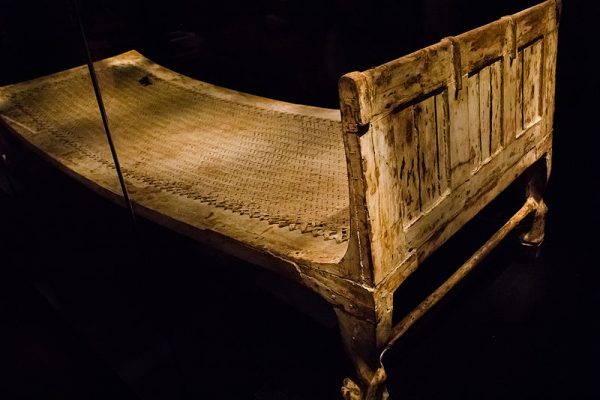The History of First Bed, Ever since the dawn of time, and the evolution of man, surely, there is one thing that we can all agree upon; humans have always needed sleep for one reason or another. The history of the bed really shows how far we have come as a human race. Although the science behind why humans really need sleep to begin with still remains rather unclear, there is one thing for certain, without it we wouldn’t be able to function the same. Research shows that getting a good night’s sleep has a wide range of health benefits, including improved memory and information retention, along with being able to rest and rejuvenate our muscles, and regulate hormone production. Some serious side effects of not getting enough sleep include things like high blood pressure, diabetes, obesity, and sometimes even heart failure. Simply put, without it, we would all be in much less healthy state of being.

Well, since humans have always needed their sleep, there must have always been a need for a place to sleep. Just like with anything else, there is a long history and evolution of what we now know as the modern day bed. While it may be hard to imagine a time where there was anything else but a pillow top mattress and a platform bed, humans didn’t always have quite the same luxuries as we do today.
So, what exactly is the history of the bed?
The oldest known mattress dates back to nearly 77,000 years ago, it was discovered by researchers in KawZulu-Natal, South Africa. The ancient hunter-gatherers of that time used sedge grass to construct a mattress made of aromatic leaves that seemed to have served several purposes. Not only did they line the floor of hard caves with this aromatic material but the leaves contained a natural insecticide, repelling any unwanted insects while providing additional comfort on the hard floor of a cave. The mattress was wide enough to fit a whole family. To this day, people living around the uThongathi river in South Africa still use sedge to make their mattresses.
It wasn’t entirely uncommon for ancient hunters and gatherers to sleep on piles of leaves and debris, however, we can thank the ancient Egyptians for many inventions and technologies, including having a written language and sleeping on a raised bed. This allowed you to sleep off of the cold floor and higher away from rodents and other unwanted pests. The embellishment of your bed also likely signified your status in the community, if you were a peasant your bed was likely just made from wood, but if you were of higher status it would be adorned with gold, jewels, or ebony. It was around this same time (around 3000 B.C.) that Persians began using goatskins filled with water, it was common to leave them out in the day to heat up from the sun and bring them in at night to sleep on.

The Romans were perhaps most famous for their beds, and they weren’t just restricted for the bedroom. They had marriage beds, beds for eating on their side, beds for studying, and beds for the dead. The chamber beds were used for sleeping and the wealthier citizens slept on raised beds made from metal consisting of woven metal supports to hold up the mattress. Others had wooden frames with wool strings for support, if you were poor, though, you most likely were still sleeping on the floor with or without a mat for added comfort. Like the Egyptians, most beds were stuffed with things like hay, leaves, or other debris, however, the rich began using feathers inside of their mattress. No matter the class, though, woolen blankets were common among the people in Rome.
During the middle ages, the type of bed you had largely depended on your status in life. If you were poor it was most likely a hay stuffed bag on the floor barely big enough for the whole family, “hitting the hay” meant striking the hay in an attempt to dislodge any bugs from the mattress before going to sleep. If you were wealthy, your bed was likely a symbol of your status. This began the creation of four-poster beds with ornate, embellished draperies and gold, jeweled decorations. Sometimes the beds would be raised so high off the floor that a step stool was required to get in it.
The history of modern-day beds and mattresses.

Leading up to the 18th century, beds became more simpler in design. Cotton stuffed mattresses now replaced feathers, also known as down, or hay, still being suspended by an intricate design of woven ropes or wool straps that needed to be tightened in order to maintain its shape and support, giving birth to the saying “sleep tight”. It was during the 19th century that the metal coil spring mattress was invented, ultimately replacing the old woven design. While they did provide more support and comfort, they were known for being annoyingly squeaky. The 20th century was a time for bedroom inventions, with things like the murphy bed (a bed that folds up into a cavity in the wall), to the invention of memory foam, and the modern day waterbed. Although being invented several decades earlier, it wasn’t until the 1950’s that the coil spring mattress took off in popularity and became the most widely used mattress of the time.
Today, during the 21st century, there are an endless amount of possibilities as far as our choices for mattress go. With a booming online industry that has taken off with the technology of our time, you can now also get a mattress right from the comfort of your own home. We have things like memory foam, the sleep number mattress, the family bed, latex foam, gel foam, and even hybrid mattresses. Today, it seems as though mattresses are still somewhat of a status symbol. While the mattress has certainly evolved over the course of human history, one thing has remained the same: humans will always need to sleep (at least for now anyways), so you may as well







